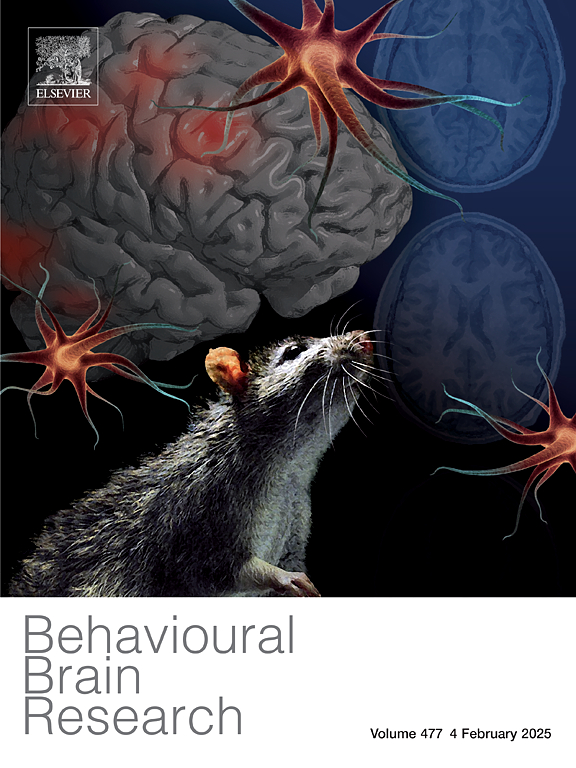非自杀性自伤的神经回路及其因果临床验证。
IF 2.6
3区 心理学
Q2 BEHAVIORAL SCIENCES
引用次数: 0
摘要
背景:非自杀性自伤(non - suicide self injury, NSSI)是指在没有死亡意图的情况下,对身体组织造成的故意伤害。这种行为显著影响个体的心理健康和社会功能。鉴于自伤的神经机制尚不清楚,本研究旨在探索参与自伤的神经回路,以改善自伤并提供替代治疗方案。方法:本研究通过系统的文献检索、选择和meta分析,将激活似然估计(ALE)与网络映射理论相结合,对自伤回路进行定义。此外,我们还进行了一项由神经导航引导的经颅磁刺激(TMS)治疗的临床试验,以验证所定义的自伤回路的准确性。结果:ALE荟萃分析确定了左侧海马旁回(PHG)的显著差异。自伤回路包括双侧PHG和扣带回、双侧额叶中回、颞中回、颞下回、顶叶以及小脑、枕叶和脑干部分。一项针对自伤回路的经颅磁刺激的临床试验显著改善了自伤症状。此外,自伤回路的特定脑区活动水平也发生了显著变化,并与自伤症状的改善显著相关。结论:本研究成功探索并验证了使用靶向治疗的自伤回路。针对自伤回路的经颅磁刺激显著改善了自伤症状,并改变了自伤回路特定脑区的活动水平。这些发现为深入了解自伤的神经机制提供了新的视角,并为开发新的治疗方法提供了科学依据。本文章由计算机程序翻译,如有差异,请以英文原文为准。
Neural circuit for non-suicidal self-injury and causal clinical validation
Background
Non-suicidal self-injury (NSSI) refers to the intentional damage inflicted on one's body tissues without the intent to die. This behavior significantly affects individuals' psychological health and social functioning. Given the unclear neural mechanisms of NSSI, this study aimed to explore the neural circuits involved in NSSI to improve and provide alternative treatment options.
Methods
This study combined Activation Likelihood Estimation (ALE) with network mapping theory through a systematic literature search, selection, and meta-analysis to define the NSSI circuit. Additionally, a clinical trial of transcranial magnetic stimulation (TMS) treatment guided by neuronavigation was conducted to verify the accuracy of the defined NSSI circuit.
Results
The ALE meta-analysis identified a significant difference in the left parahippocampal gyrus (PHG). The NSSI circuit included bilateral PHG and cingulate gyrus, bilateral middle frontal gyrus, middle temporal gyrus, inferior temporal gyrus, parietal lobes, and portions of the cerebellum, occipital lobe, and brainstem. A clinical trial of TMS targeting the NSSI circuit significantly improved NSSI symptoms. Moreover, significant changes were observed in the activity levels of specific brain regions of the NSSI circuit, and were significantly correlated with the improvement of NSSI symptoms.
Conclusions
This study successfully explored and validated the NSSI circuit using a targeted treatment. TMS targeting the NSSI circuit significantly improved NSSI symptoms and changed the activity levels of specific brain regions of the NSSI circuit. These findings offer a new perspective for a deeper understanding of the neural mechanisms underlying NSSI and provide a scientific basis for developing new treatment methods.
求助全文
通过发布文献求助,成功后即可免费获取论文全文。
去求助
来源期刊

Behavioural Brain Research
医学-行为科学
CiteScore
5.60
自引率
0.00%
发文量
383
审稿时长
61 days
期刊介绍:
Behavioural Brain Research is an international, interdisciplinary journal dedicated to the publication of articles in the field of behavioural neuroscience, broadly defined. Contributions from the entire range of disciplines that comprise the neurosciences, behavioural sciences or cognitive sciences are appropriate, as long as the goal is to delineate the neural mechanisms underlying behaviour. Thus, studies may range from neurophysiological, neuroanatomical, neurochemical or neuropharmacological analysis of brain-behaviour relations, including the use of molecular genetic or behavioural genetic approaches, to studies that involve the use of brain imaging techniques, to neuroethological studies. Reports of original research, of major methodological advances, or of novel conceptual approaches are all encouraged. The journal will also consider critical reviews on selected topics.
 求助内容:
求助内容: 应助结果提醒方式:
应助结果提醒方式:


